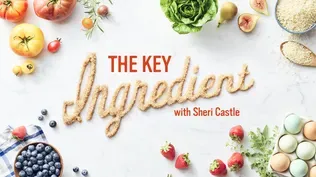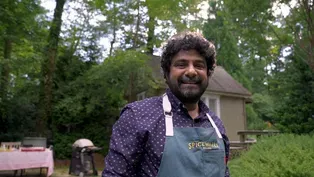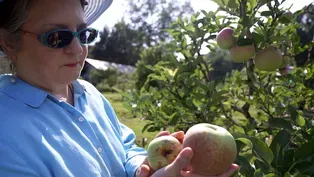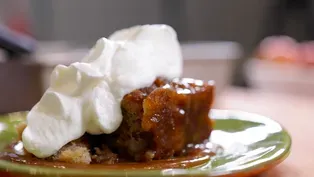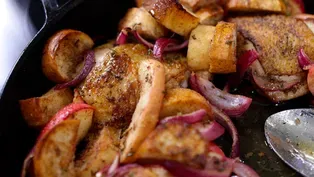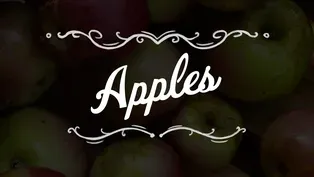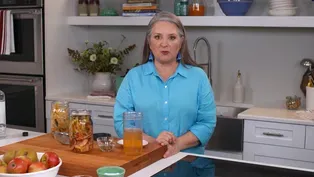
The Apples of My Eye
9/11/2023 | 26m 47sVideo has Closed Captions
Sheri shares her love of every kind of apple with scrumptious apple recipes.
Sheri shares her love of every kind of apple, especially the heirloom varieties with scrumptious apple recipes. Sheri uses apples from nearby Century Farm Orchards to create her roasted chicken with apple pan dressing and fresh apple cake with caramel glaze complimented with a delicious apple cider-bourbon caramel sauce and tangy whipped cream. A cook along with Chef Meherwan Irani takes the cake.

The Apples of My Eye
9/11/2023 | 26m 47sVideo has Closed Captions
Sheri shares her love of every kind of apple, especially the heirloom varieties with scrumptious apple recipes. Sheri uses apples from nearby Century Farm Orchards to create her roasted chicken with apple pan dressing and fresh apple cake with caramel glaze complimented with a delicious apple cider-bourbon caramel sauce and tangy whipped cream. A cook along with Chef Meherwan Irani takes the cake.
How to Watch The Key Ingredient
The Key Ingredient is available to stream on pbs.org and the free PBS App, available on iPhone, Apple TV, Android TV, Android smartphones, Amazon Fire TV, Amazon Fire Tablet, Roku, Samsung Smart TV, and Vizio.
Providing Support for PBS.org
Learn Moreabout PBS online sponsorship[upbeat music] ♪ - You could say that these are the apples of my eye.
Each of these beautiful heirloom apples has its own unique taste, texture, flavor, and story.
We're cooking at home with these little beauties.
We're going to make a fresh apple cake with a caramel glaze.
And come along for a modified fruit lesson with my friend, the apple man, David Vernon at Century Farm Orchard.
♪ And then to the backyard of chef Meherwan Irani, who's going to show us how he makes apples at home in a delicious apple sabzi.
- [Meherwan] It's not just the taste, it's the smell that hits you out of the bat.
- [Sheri] And standby for this great one can chicken with apple dressing recipe.
It is weeknight simple, but it tastes like a special occasion.
I'm Sheri Castle.
I write cookbooks.
I write for food magazines.
I cook, I teach, and I collect stories.
And my favorite stories are the ones behind our best loved home recipes.
- Is it time to shuck 'em?
- It's time to shuck 'em.
Cheers!
- [Sheri] Oh!
That's awesome.
I will go out and explore, from the ground up, the best ingredients that go into some of our most beloved family recipes.
It's all about the food, the flavors, and finding the key ingredients.
We're at Century Farm Orchard in Caswell County, North Carolina.
Over 500 different kinds of apples grow right here in this orchard, but it's only a fraction of the mini varieties that once flourished in the American south.
Today, I'm going to visit with my friend noted homologous scientist, David Vernon.
He's a good guy.
He's an apple guy, and he's going to teach us all how to know apples, love apples, and then cook with apples.
Well, hello there.
It is so good to see you again!
- Hey!
Nice to meet you.
- How've you been?
- It's been several years.
- [Sheri] Been several years and a lot of apples!
So what's been going on?
What you got going out here these days?
- We've just started picking some apples.
The last couple of weeks, kind of cleaning up, making sure that the nursery trees we're growing are in good shape and just kinda waiting for fall to arrive and the cooler temperatures.
- That is something.
You know, people associate apples with falls, but one of the things you taught me when we met a few years ago was, is there's actually an apple for all seasons that you've got something going on all year to get ready for harvest.
Well, what have you got going right now?
What are we going to look at today?
- [David] What we're going to do is we're going to look at some of the apples we've harvested recently, and some that are still on the tree.
And I know you're looking specifically for cooking apples too.
So we're going to go to some of the trees that make some of the more delicious treats, whether they're a baked apples or, fried apple pies or just, it could also be eating apples too.
But, we're going to look at some of the apples that are actually available now this time of the year.
- Oh, let's go look at that.
- Great.
I look forward to it.
- [Sheri] So tell me about this tree.
You know, one of the things that you have taught me is you can't judge a good taste in apple by necessarily how it looks.
Those are beautiful, gnarly Russetts.
Tell me, why it's called that.
- Well, this is a Roxbury Russet.
It is the oldest named apple variety in America.
Europeans brought over apples when they came over and a lot of them they brought over their own trees or they brought over apples and planted seeds.
When they brought their own plants over then those were native to Europe and then they planted them here.
And a lot of people aren't used to seeing an apple that isn't red or yellow or, or has beautiful color.
This is a russet and you can see an underlying of green there, but it's covered with almost a potato feel to it or a rusty or a sandpaper type.
And people weren't used to actually seeing that.
And they aren't used to actually tasting that when they bite into it and eat it fresh.
- That is so amazing.
There's that crunch, but there's juiciness in there.
Sweet, but it won't make your head hurt.
It's not that sweet.
No, it's the acid.
There is almost a tropical thing about it.
A little bit of a Tropic in there from an apple out of Caswell County.
My stars.
That's an apple.
So tell me about an apple that came from your family.
That might've been the apple and you grew up here.
- Well, the one that comes to mind first is the Mary Reed apple.
The Mary Reed, there's only two families in Caswell county that grew this apple.
And my aunt was one of the ones that preserved this apple.
And when I was a child, I thought everyone had a Mary Reed apple.
But of course I learned later that they don't, this apple was very versatile.
It starts ripening in mid July and will continue to drop apples until like the first or second week of September.
- Yeah, I think I know what this is, but before I stick my foot in my mouth, I want you to tell me and confirm my suspicion is this, in fact, the famous?
- Magnum bonum.
- Got it!
- And Magnum bonum is Latin for great, good.
And it is a fantastic apple for all purposes.
It's slightly well referred to as mildly tart.
It makes great cider.
So what I've got Sheri for you is some cider and this is the cider that we've made with our own home press, and this is just what we call sweet cider.
It is not fermented at all.
Squeeze the apples.
We press them down.
We made cider.
And so this is just plain old sweet cider.
- I have a feeling it's not going to be that plain at all.
I think it's going to be something else.
- No watering down with that.
- That is so good.
I think that so much cider people have had just tastes like apple juice, like a juice box.
This is a beverage.
This is like drinking your orchard.
There's some sweet, there's some tart.
There's an amazing aroma.
It's got color.
People need to pay attention to cider the way they do to their wine or something.
And if you're just using whatever your apples are in any given season, you've never made the same side or twice have you?
- Oh no.
Its different every year.
- So from David's orchard to my kitchen, here are some of the amazing heirloom apples that he shared with me.
And I'm going to use them in one of my favorite recipes of all time.
It is a fresh apple cake with caramel glaze.
This cake is so good.
You're going to love it.
I call it a countertop cake.
You know, the kind of cake I mean.
It's one that stays fresh for days, which means you can put it on the back counter in the kitchen and when people want a bite, they can go serve themselves.
So we all know that caramel and apple are two classic flavors that always go together.
Well, in this caramel recipe, the apple is in the caramel.
This is made with cider and it is so easy.
And it keeps for up to a month in your refrigerator.
This is how we do it.
What we have here is a little all purpose flour, and I'm going to add some leavening in the form of baking soda, a little bit of salt, and then some beautiful spices.
I have cinnamon coriander and cardamom, and I have a little bit of freshly ground nutmeg.
So I sifted these, not necessarily to take out the lumps.
When it's mixed in evenly, that means that it's going to distribute its flavor throughout the batter.
Now we're going to make the wet part of the cake.
We have brown sugar and we have granulated sugar and we have cooking oil.
You can use whatever sort of vegetable oil that you have, but I'm a big fan of grape seed oil in a recipe.
Now we're going to take the mixer and we're going to blend this.
Why am I using the mixer?
Sugar, actually performs as a liquid ingredient in a cake.
It's why it goes in with the other wet stuff instead of the other dry stuff and you want to make sure that you mix this long enough for the sugar to get creamy and soft and dissolve in this oil.
And it looks coincidentally like apple sauce.
And when it looks like that, it's time to add the eggs.
Now I'm going to beat each egg in one at a time very well incorporated until there are no traces of the yellow before I add in another one.
Okay.
So now we have all three eggs in there.
Now the next part is we're going to add the dry ingredients into the wet in about thirds.
And then we're going to beat it on low speed.
You don't want to put any more air in a cake at this point.
You're just turning the mixer on enough that that flour's going to mix into the eggs.
All right.
So there are the beaters.
You know, a smart cook knows to lick the beaters, but a wise cook knows to turn the mixer off first.
So even though we've used the mixer, you always want to take a spatula and scrape down the bowl.
We have a tiny bit of vanilla, and then we're going to add our apples.
I like them a little bit chunky so that they will stay in the cake that you can see the little different bites of apples.
So I'm going to mix these apples in and some walnuts, and then I'm going to stir them in by hand and with a little elbow grease, every apple chunk is going to be coated in batter, and then it's time to go in the pan.
So this cake bakes in a non by 13 pan.
It's so full of apples.
So that is all of our batter in the pan.
And this is going to go in a fairly low oven, only 325 degrees.
This is unfiltered cider.
It's important to use the unfiltered because it has more of that fresh, delicious, robust apple flavor.
We're going to put a little bit of brown sugar.
This is a little bit of ground cardamom, a pretty healthy pinch of ground cinnamon and a little bit of mace.
And then we're going to put in some bourbon and fresh lemon juice, and we're going to bring this up to a boil.
So I've started to heal all that brown sugar has dissolved, and I'm going to add two more things.
This is a little bit of light corn syrup, and the reason we're adding that is because it will keep the caramel from crystallizing so it will stay nice and smooth while it cooks.
Then the last ingredient is heavy cream.
And, this should be at a good simmer.
Now what's the difference between a simmer and a boil?
A simmer is just gentle little bubbles around the edge of the pan.
A boil is a active, exploding bubbles.
We don't want that.
We want this to cook low and slow so just a gentle simmer for an hour and a half to two hours, but it doesn't have to be monitored.
It's going to do its own job without you in the room.
So this is caramel alchemy, two hours, all of that milky, cidery, spicy stuff condenses, and the flavor concentrates, and you wind up with about a cup or a cup of half of this amazing caramel.
And it will stay in a jar in your refrigerator for up to a month.
So the last step in this cake is a very simple glaze.
We're going to put in four tablespoons of butter, some granulated sugar and some brown sugar.
And we're going to cook that until the sugar's dissolved in the butter and it's good and smooth.
Then we're going to add in some cream.
So we're going to move the pan off the heat.
And we're going to stir in some vanilla extract and a big pinch of salt.
You know, the salt actually balances some of the sweetness of the caramel and makes it taste even better.
So the cake has been out of the oven long enough to cool off to room temperature.
And now we're going to put the glaze, but first we're going to poke holes in this whole thing.
What that's doing is making room for this glaze to go down into the cake.
And there we go.
We have a glazed cake.
I'm going to put a delicious dollop of this amazing caramel on the plate.
And then we're going to top it with a big hunk of our cake.
♪ [upbeat jazz music] It's ready.
♪ ♪ Yes, its ready.
♪ ♪ So just let it all begin.
♪ - Now for a real treat, you're invited to some fun backyard dining with a chef who loves cooking with apples, especially at home.
- Hi, my name is Meherwan Irani.
I'm a chef and restaurateur.
I'm the owner of the Chai Pani restaurant group here in Asheville, North Carolina.
I didn't grow up cooking in India.
Contrary to the lore that I could easily spin of me growing up cooking by my mother's side.
If you know anything about Indian culture, the reality is like usually boys were not in the kitchen.
So I started experimenting with cooking in grad school, in my little dorm, and it became a thing.
And that started a love affair with food primarily because I was trying to recreate something from way back when.
Apples in India are not the fruit like it appears to be quite often in North Carolina.
We almost never, we rarely cook with it unless we're making one of two things, some sort of Indian shot, or we mix it like a stew.
We call them sabzi in India and sabzi any vegetable that's cooked slightly dry.
So I'm going to make an apple sabzi.
Many spices smell don't necessarily translate to just also the flavor they're going to add to the dish.
And the single best way to figure out flavors a spice is going to add is to bloom them in oil.
So we're going to go ahead and get our onions diced up.
We're going to get our chilies chopped.
And we're going to core, and peel, and quarter our apples.
I've got some fresh spices.
We'll snip a little, Curry leaves from the Curry plant.
I've got a little fresh coriander plant in the backyard, cilantro, and we'll take some cilantro stems.
And once we have everything we need prepped up 5-minutes, 10-minutes.
It's a quick, it's a quick satay, a quick sear.
It'll be delicious.
The first trick here with most Indian cooking is to go ahead and temper the spices in oil, coconut oil for this one, because you really want that coconut forward flavor in this.
And next is mustard seeds.
The trick for putting mustard seeds in oil is to get the oil really hot.
Cause if you just pop the mustard seeds in while the oil is not really sizzling, they're not going to actually pop and release.
They're just going to cook and burn.
And here's a way to test.
Drop one or two seeds in there.
If they don't start wiggling sizzling or popping, oil isn't hot enough.
And see that popping action that's starting to happen?
That's what we want.
The minute they start pop, turn the heat down to low and then add the Curry leaves.
And they started to pop and step back a little bit when adding Curry leaves, cause you're going to get little spluttering.
But what's happening now is the mustard seed and the Curry leaves is flavoring the oil and that flavor is going to be imparted through the entire dish.
Going in with my onions now.
Alright, so we're gonna let the onions sweat and get to a nice golden brown.
One ingredient that's optional to this dish.
I love the taste of peppercorns.
I should've added these in early, but just a few whole black peppercorns in, even now, not too late.
If you're going to put powdered spices, now you put them in so that they don't burn.
So I'm gonna put coriander in.
I'm going to put turmeric in.
I'm going to put the red chilies in.
All right, final steps.
I'm going to add the fresh grated coconut.
Most grocery stores do sell frozen fresh grated coconut.
Coconuts in, and now my apples.
In order to sweat the apples down and let them cook down, you've got two options.
You can add water, or if you want to take it up a notch, add some coconut milk.
I like the whole kind.
Don't get the light coconut milk.
If we're going to use coconut milk, just go for the good stuff.
This is a good place to taste it.
See if it needs anything.
Little more salt.
So everything's done.
All we need now is time and the judicious application of heat.
And we'll do that by putting a lid on this, turn down low and let it simmer for about 10 minutes and let those apples completely cook all the way through.
And this dish will be done.
It's sort of dry, wet, and that's exactly what we want.
You don't want it so dry to where you don't have a little bit of liquid, but you don't want it so wet to where it's a curry or gravy.
This is perfection.
So right now a bowl of rice with some dahl and little bit of the sabzi in the side would be perfect.
So I think the only thing that's needs is some color.
I love cilantro.
It really is finishing a dish.
So there is!
Apple sabzi a la Meherwan's backyard.
Hope you enjoy see you soon, Sheri.
- [Sheri] All of these recipes are something that you can do at home.
We want you to feel confident and have fun and feel successful at each step of the way.
This is a one pan meal.
Everything we're going to eat and serve is made in one skillet.
Come on, let's get started.
I love a good, reliable cast iron skillet, but anything you have that will go in the oven will be fine.
So there are four chicken thighs on this plate.
I've blotted them dry with paper towels so that when they go in the hot pan, they're going to start cooking and turning crispy instead of steaming.
Gonna put some salt and pepper on both sides.
Pretty generously salt and pepper.
And then we're going to put a little bit of fat in the skillet.
If oil will give you a good cooking medium, that's going to crisp up this chicken, but it doesn't taste like much, butter tastes great, but it tends to burn in the hot pan.
So if you do a little look, both, you're getting the best of both and it's going to be the perfect thing to make this chicken term brown and crispy.
We're going to put these chicken thighs in the skillet skin side down.
If you ever put food in a pan and you don't hear anything, your pants not hot enough.
And that's all you have to do so far.
So the next step is to start on what is a pan dressing.
I have here, two apples that I've cut up and we're going to add a little brown sugar, some dry mustard, salt, and pepper.
And then a little bit of spice.
I'm using apple pie spice.
If you're looking for a lot of flavor in just one pinch, some of these spice blends like this, give you a lot of flavor bang in one simple step.
It's just that simple.
That's all you have to do.
Yeah, we're going to use some onion.
You cut the top and then cut it from top to bottom this way.
Then we're going to cut this end off and peel the onion.
You may have never noticed that every onion has little ridges on it.
It's like mother nature is trying to show us where to cut.
These are like the cutting guides and we're going to follow the shape of the onion, cut all the way around, and look what happens.
With that cut alone you have these beautiful little Julianne pieces.
So we're going to add a little bit of this onion to our bowl of apples.
And then we're going to add some fresh thyme leaves.
And I like to make sure that the apple and the onion is really well coated in those spices.
And then we're going to add the other component that makes this a dressing and that is bread.
You want it to have some texture to it?
Not too flimsy.
I wouldn't use say a sandwich bread.
Put those into fairly large bite size pieces.
And then we're going to toss this together.
And this part is done until our chicken is ready to turn and cook the other side.
We're going to garnish this with some dried fruit.
These are dry cherries, but you can use golden raisins and we're going to plump them up.
But instead of water, this is apple cider vinegar, which is going to give them this sort of sweet and tangy and delicious combination of flavors and a little bit more apple.
And all you do is pour the vinegar over the cherries and set them aside.
See how this chicken is coming.
So it's about 12 minutes on medium heat.
It's tempting to want to crank that heat really up to rush things along, but if you do that, instead of getting a nice golden skin on the chicken, it's going to burn around the edges and be raw in the middle.
So slow and steady is the way to do it.
So let's flip these babies over and we have this gorgeous brown, crispy skin, and we're going to make a little space.
And then I'm going to put in my pan dressing.
This dressing is going to nestle between the pieces of chicken and it's going to cook in the delicious chicken juices.
And that's it.
Now I'm going to transfer this to a hot oven and let it finish cooking in the oven.
So it's been about 25 minutes and that chicken ought to be done.
Let's check it out, put this down here.
My goodness, look at this.
So the apples have gotten tender, but they've not fallen apart.
Our little bits of onion are all caramelized and delicious and we have chicken juices.
On this plate, I have a little bit of some leafy greens.
There's some baby chard.
There's some baby kale, any kind of sturdy leafy salad green that you like will be great on this.
And then we're going to lift out a piece of this delicious chicken, put that in the middle.
And then we're going to spoon some of this delicious pan dressing around the side.
Make sure everybody's got some of that bread.
Some of this bread has soaked up the juices.
And in the bottom are these delicious juices.
Now, remember earlier when we put those dry cherries in to soak, they have now plumped up and have turned this apple cider vinegar, almost like a vinegarette.
And for a little bit of color and a little bit of acidity to balance those rich, meaty, delicious fatty chicken juices.
We're going to put a few of these cherries and a little of that vinegar and there you have it.
So, you know, the final mark of a successful recipe is does it taste like I want it to?
So let me take a bite of this and I'll let you know what I think.
Let me tell you what's going on here.
We have sweet apples that have held their shape, but they're tender all the way through, we have a little bit of carmelized onion, we have a sauce on here, it's a whole dinner party on the end of your fork.
This is good!
[whimsical music] ♪ >> So when I was growing up in the mountains of North Carolina, my family used to tell me that you should always peel an apple in one long continuous strip of peel and then if you dropped it over your left shoulder, it would form the first initial of your one true love.
I'm not sure about that so i've got a much better use of apple peels.
As you're making your recipe through the day collect your cores and your peelings and put them in a jar and we're going to turn this into magical infused vodka.
and we're going to add a vanilla bean.
you can use a fresh vanilla bean or you can use one left from another recipe.
Just chunk it down in a jar, drop in a couple of cloves, a couple of cardamom pods and then you fill your jar with some vodka, and then once it's all full, you put the lid on the jar, and you let it sit in a cool place for 4 days at least and up to 2 weeks.
the longer it sits, the more infused the apple flavor is into the vodka.
At the end of the few days.
voila!
This is what you have.
when it tastes to your liking - and you should taste a little every day - you just strain it out, and you have this incredible spiced Apple vodka infusion.
Now what do I like to do with this?
It is plenty good to just sip straight up.
But it is excellent in a cocktail and I really like it's stirred into a warm cup of apple cider.
that's what you can do with your apple peels.
As you can see, apples have history, and each one has its own story.
There are hundreds of kinds of apples which makes them versatile and easy to enjoy in all sorts of sweet and savory dishes.
>> Sure these are my parents, this is Cy Vernon and Janice Vernon and they both help me a great deal, in fact my dad is my right hand man.
>> Obviously his left is injured.
- So what have you got here?
- This is creamy apple squares.
- That is really good.
you can taste apples, they're tender but they're intact, you've got the cream in there a little brown sugar and stuff, Yeah, thank you so much!
It's delicious.
when picking out your apples, don't forget each variety has its own special taste, texture and personality.
There's always a just right apple for any recipe that key ingredient to make every bite a delicious aha moment.
>> This is my grandfather's cider mill, - Uh-huh.
- and this is the original receipt from July 27th, looks like 1929, - Wood adds flavor to things.
- It does.
- It's got to be part of this.
♪ For all the recipes from the show visit our website.
It's where you'll find the key ingredient for a perfect time in the kitchen.
Apple Sabzi | Cook Along with Meherwan Irani
Video has Closed Captions
Chef Meherwan Irani shares his delicious Apple Sabzi recipe with Sheri. (4m 10s)
Field Trip to Century Farm Orchards
Video has Closed Captions
Sheri gets a mighty fine fruit lesson from her friend David Vernon, the “Apple Man.” (4m 41s)
Fresh Apple Cake with Cider Caramel | Kitchen Recipe
Video has Closed Captions
A fresh apple cake with caramel glaze is on Sheri's menu with a cider caramel sauce. (6m 30s)
One Pan Chicken & Apples | Kitchen Recipe
Video has Closed Captions
Sheri uses apples from a nearby orchard to create her One Pan Chicken & Apples recipe. (6m 31s)
Preview | The Apples of My Eye
Video has Closed Captions
Sheri shares her love of every kind of apple with scrumptious apple recipes. (30s)
Sheri Says: Infused Apple Peel Vodka
Video has Closed Captions
Sheri shares an amazing tip for those extra apple peels laying around involving vodka. (1m 45s)
Providing Support for PBS.org
Learn Moreabout PBS online sponsorship